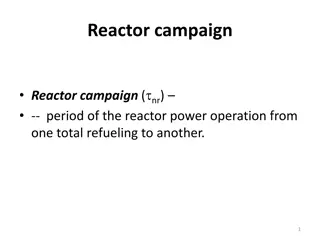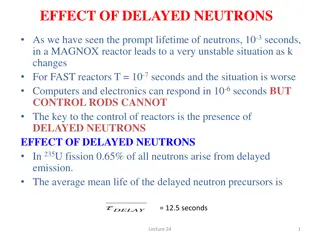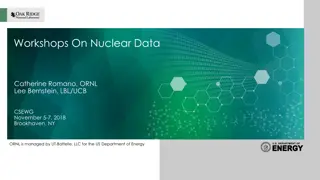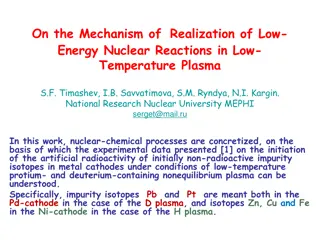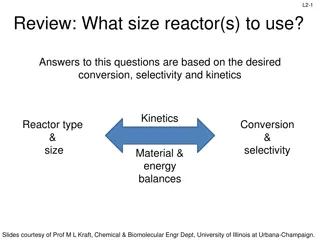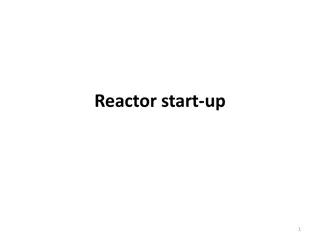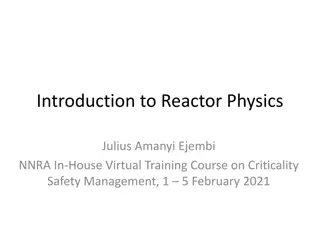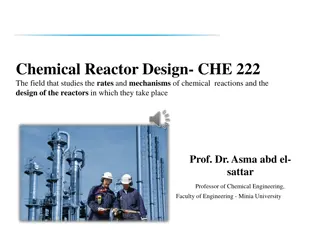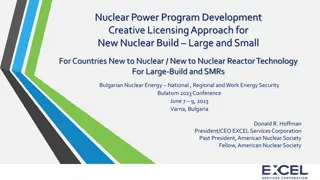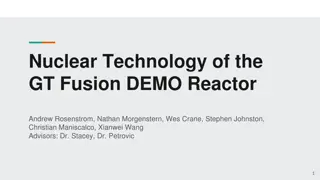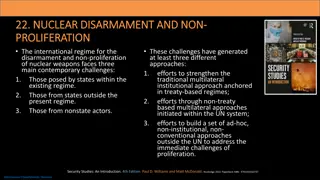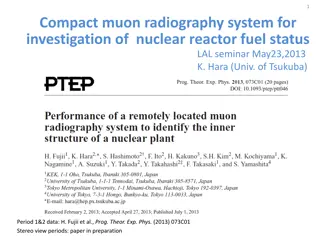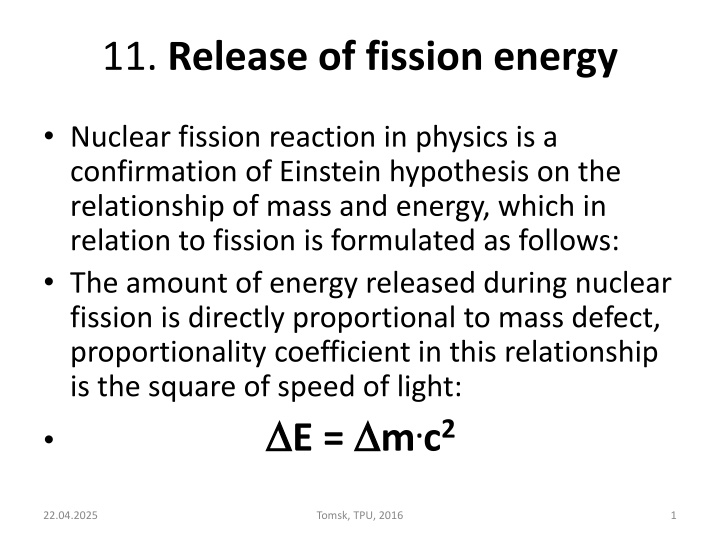
Nuclear Fission Energy and Mass Relationship in Physics
Explore the fascinating world of nuclear fission energy and its correlation with mass, as described by Einstein's hypothesis. Learn how the energy released during fission is proportional to mass defect, and delve into the detailed analysis of excess defect masses and energy distribution in fission reactions.
Download Presentation

Please find below an Image/Link to download the presentation.
The content on the website is provided AS IS for your information and personal use only. It may not be sold, licensed, or shared on other websites without obtaining consent from the author. If you encounter any issues during the download, it is possible that the publisher has removed the file from their server.
You are allowed to download the files provided on this website for personal or commercial use, subject to the condition that they are used lawfully. All files are the property of their respective owners.
The content on the website is provided AS IS for your information and personal use only. It may not be sold, licensed, or shared on other websites without obtaining consent from the author.
E N D
Presentation Transcript
11. Release of fission energy Nuclear fission reaction in physics is a confirmation of Einstein hypothesis on the relationship of mass and energy, which in relation to fission is formulated as follows: The amount of energy released during nuclear fission is directly proportional to mass defect, proportionality coefficient in this relationship is the square of speed of light: E = m. 2 22.04.2025 Tomsk, TPU, 2016 1
In nuclear fission, excess of (defect) masses is determined as the difference of sum of the rest masses of initial products of the fission reaction (that is, nucleus and neutron), and the resulting products of nuclear fission (fission fragments, fission neutrons and the rest of microparticles emitted in the fission process, and after it). Spectroscopic analysis allows to determine most of the fission products and their specific yields. 22.04.2025 Tomsk, TPU, 2016 2
On this basis, it was not so difficult to calculate particular values of mass defects at different results of fission of uranium-235, and using them - to calculate the average value of the energy released in a single fission, which is close to m c2~ 200 MeV 22.04.2025 Tomsk, TPU, 2016 3
It suffices to compare this value with the released energy in the event of one of the most exothermic (occurring with heat release) chemical reactions - oxidation of rocket fuel (less than 10 eV) - to realize that at the atomic level of 200 MeV - a very large amount of energy: it is at least eight orders of magnitude (100 million times) larger than the energy received during chemical reactions. Fission energy is dissipated from the volume where there was nuclear fission through a variety of material carriers: fission fragments, fission neutrons, - and - particles, -quanta and even antineutrino. 22.04.2025 Tomsk, TPU, 2016 4
Distribution of fission energy between the material carriers in the fission of 235U is given in the table. Carriers of fission energy Released energy, MeV 1. Kinetic energy of fission fragments 166 2. Kinetic energy of fission neutrons 5 3. The energy prompt gamma-quanta 4. Energy -rays from fission products 5. Energy of -emission of fragments 7 7 9 6. Energy of antineutrino 10 Total: 203 22.04.2025 Tomsk, TPU, 2016 5
Various components of fission energy are transformed into heat at different times. The first three components turn into heat in less than 0.1s (as from the moment of fission) and, therefore, are called instantaneous sources of heat. - and -radiation of fission products are emitted by excited fragments with the variety of half-lives (from a few fractions of a second to many hundreds of days), and therefore the process of afterheat can last tens or hundreds of days after reactor shutdown. 22.04.2025 Tomsk, TPU, 2016 6
Where and what part of fission energy is transformed into heat in the reactor? Fuel composition, which includes fissile nuclides, is contained in sealed enclosures preventing the escape of resulting fragments of fuel elements (FE) to the coolant cooling them. And if the fission fragments in proper reactor do not leave FE, kinetic energy of the fragments and weakly penetrating -particles are converted into heat inside FE. 22.04.2025 Tomsk, TPU, 2016 7
The energies of fission neutrons and -radiation are transformed into heat inside FE only partially: penetrating ability of neutrons and - radiation generates carry-over of most part of their initial kinetic energy from the place of their birth. Approximately 90-95% of all fission energy (i.e. 180-190 MeV) inside FE is transformed into heat. Part of fission energy received in the form of heat outside FE in the reactor core depends on its type and apparatus and is within (6 9)% of total fission energy. 22.04.2025 Tomsk, TPU, 2016 8
The rate of fission reaction is related to the number of free neutrons in the reactor core environment, since they cause fission, radiation capture, neutron scattering and other neutron reactions. Therefore, the rate of fission reaction, energy release in the core and thermal reactor power is related to the characteristics of the neutron field in its volume. 22.04.2025 Tomsk, TPU, 2016 9
12. Main characteristics of neutron fields Neutron Field - a set of free neutrons moving in a certain way and distributed in the volume of the material environment. In particular, in the volume of the reactor. 22.04.2025 Tomsk, TPU, 2016 10
To characterize one or another neutron field and understand the difference between them, a few simple questions should be answered: - How many neutrons at a given moment of time are in unit volume of the medium? - What are these neutrons, how they differ from each other and what is their overwhelming (determining) majority of the total number of neutrons of different qualities? - What is the character of motion of neutrons - chaotic, complex or directed? 22.04.2025 Tomsk, TPU, 2016 11
To answer these questions, it is required to use quantitative characteristics of neutron fields. The main characteristics that define differences of neutron fields are: - neutron density n (neutron/cm, cm-3); - speed of neutrons - v (or their kinetic energy - E = mv2/2) (MeV); - neutron flux density (neutron/(cm2*s), cm-2s-1); - current density of neutrons I (neutron/(cm2*s), cm-2s-1) (cm/s); 22.04.2025 Tomsk, TPU, 2016 12
13. Neutron density (n) Neutron density is the number of neutrons that are at a given time in a unit volume of medium. From this definition, it follows that the dimension of the density of neutrons - neutrons/cm3, or formally - cm-3. The density of neutrons is a static characteristic: in the definition there is no hint that the neutrons move. It focuses attention on the fact of the presence of a certain number of neutrons in a given time in a unit volume of the medium, without giving any representation of the character or of the direction or speed of their motion. 22.04.2025 Tomsk, TPU, 2016 13
Nuclear standard recommends the definition: Neutron density - is the ratio of the number of neutrons that are at a given time in the volume of the elementary sphere to the value of the volume of the sphere. 22.04.2025 Tomsk, TPU, 2016 14
Speaking of neutron density we should always indicate which of the neutron energy is in question. Mathematical notation - n (E) - means this: the value of the neutron density and the amount of kinetic energy are indicated. Since in a single volume, in addition to neutrons with energy E, there are neutrons with a wide variety of energies of a wide range, total (integral) neutron density of all possible energies will: 22.04.2025 Tomsk, TPU, 2016 15
14. Speed of neutrons (v) or their kinetic energy ( ) In a nuclear reactor there is a wide range of free neutrons of kinetic energies - from 10-4eV to 18 MeV. To see their differences, they are classified into: - fast neutrons (with kinetic energies higher than 0.1 MeV); - intermediate neutrons (with energies 0.625eV E 0.1MeV); - slow neutrons (with energies lower than 0.625 eV). 22.04.2025 Tomsk, TPU, 2016 16
The need for this classification is due to the fact that neutrons of different kinetic energies have different propensity to join various neutron reactions with nuclei of some substances. 22.04.2025 Tomsk, TPU, 2016 17
A critical part of slow neutrons account for thermal neutrons - i.e. neutrons which are in kinetic equilibrium with the nuclei of medium in which they move. Since energy distribution of molecules and nuclei of atoms in their thermal motion has the form of Boltzmann spectrum, thermal neutrons should have similar distribution in non-absorbing medium. Therefore, energy spectrum of thermal neutrons - Maxwell spectrum - in the ideal medium not absorbing thermal neutrons is formally described by the same expression: n(E)dE = no*C*E*exp(-E/kT) dE , 22.04.2025 Tomsk, TPU, 2016 18
where: n(E) - density of thermal neutrons having energies in the elementary interval dE close the value E; no - integrated density of all possible energies in the medium with thermodynamic temperature T; k = 8.62 .10-5eV/ - Boltzmann constant; - normalization constant factor. n(E)dE = no C E exp(-E/kT) dE , 22.04.2025 Tomsk, TPU, 2016 19
Maxwell spectrum of thermal neutrons has the following inherent energies of thermal neutrons: ) The most probable energy Emost probable= kTneutrons corresponding to the maximum of thermal neutrons distribution by the energies at the temperature of neutrons Tneutrons. This means that the number of thermal neutrons having kinetic energy Emost probablein the medium is greater than thermal neutrons any other energies (up to 36% of the total number of thermal neutrons). Emost probable= 0.0253 eV 22.04.2025 Tomsk, TPU, 2016 20
b) Average energy of thermal neutrons: 0 n o 1 = ( ) E n E dE The neutron spectrum, i.e. their energy distribution in the medium, is the second characteristic of a neutron field. average= 0.0322 eV 22.04.2025 Tomsk, TPU, 2016 21
Speed spectrum of thermal neutrons - Maxwell speed Maxwell and hyperbole "const / v" at which the maximum of spectrum slides with increasing of thermal neutrons temperature 22.04.2025 Tomsk, TPU, 2016 22
15. Neutron flux density The third of the main characteristics of neutron fields - neutron flux density ( ) - the product of the first two: density of neutrons multiplied by their speed: = n . v 22.04.2025 Tomsk, TPU, 2016 23
In the physical sense, this value - total second path of all neutrons in 1 cm3of the medium. However, the dimension of the flux density - neutrons / cm2s - can lead to confusion in trying to discover the physical meaning of this value in the dimension itself: once a certain flat area with the size of 1 cm2 is imagined, through which a certain number of neutrons passes every second. 22.04.2025 Tomsk, TPU, 2016 24
The probability of interaction of the nucleus with neutrons, crossing the surface of the sphere of nuclear forces of the nucleus from outside, should be proportional to the neutron flux density near the nucleus - ratio of the number of incident neutrons per 1 s on the surface of the sphere of neutrons to the value of the surface of this sphere. 22.04.2025 Tomsk, TPU, 2016 25
Nuclear standard gives the definition: Neutron flux density ( ) - is the ratio of neutrons incident on the elementary sphere surface every second, to the value of the diametric cross section of this sphere. 22.04.2025 Tomsk, TPU, 2016 26
Speaking of neutron flux density , be sure to specify and indicate which of the neutron kinetic energy is in question. Otherwise, there will be uncertainty. If you just say that = 60 neutrons / cm2s, it is still say nothing, because such a value of flux density can be achieved by: - one neutron with speed v = 60 cm / s; - two neutrons with speed v = 20 cm / s; - six neutrons with speed v = 10 cm / s; - ten neutrons with speed v = 6 cm / s, etc. 22.04.2025 Tomsk, TPU, 2016 27
And the results of the interaction of these combinations of neutrons with nuclei of medium in all of these cases will be different. That's why, when indicating the value, it is always important to indicate neutron energy (E). 22.04.2025 Tomsk, TPU, 2016 28
16. Neutron current density Unlike the first three characteristics of neutron fields the definitions which ignore the concept of the direction of neutrons motion , current density is a vector value. It gives an idea of the general direction of motion of large numbers of randomly-moving neutrons and the intensity of neutrons motion in this direction. 22.04.2025 Tomsk, TPU, 2016 29
The neutrons in a medium , like water molecules in a mountain river, move in all conceivable directions. But, in the river there is a general direction of water motion, so there is a similar trend for neutrons motion. 22.04.2025 Tomsk, TPU, 2016 30
Nuclear standard provides the following definition of neutron flux density: Neutron current density - a vector which module is numerically equal to the difference of numbers of neutrons crossing the unit flat area every second perpendicular to the direction of this vector, in two opposite directions. 22.04.2025 Tomsk, TPU, 2016 31
Scalar value dimension of neutron flux density - neutrons/cm2s has the same dimension as neutron flux density. However, physical meaning of these two characteristics of neutron fields is quite different. 22.04.2025 Tomsk, TPU, 2016 32
17. Rates of neutron reactions and their characteristics The speed of any neutron reactions with nuclei of i-component of medium is the number of these reactions occurring every second with these nuclei of per unit volume (1 cm3) of the medium. Reaction rates are designated by the symbol Rji, where subscript (j) indicates the type of neutron reactions and upper - (i) - is the symbol of the nuclide, isotope, chemical element or compound. 22.04.2025 Tomsk, TPU, 2016 33
If in place of subscript j in Rjisymbol is: c - we are talking about the reaction of radiative capture; f - a question of fission; a - question of absorption reaction; s - means reaction rate of scattering ; in particular, subscript of scattering can be more precise: se - refers to elastic scattering and si - inelastic scattering. 22.04.2025 Tomsk, TPU, 2016 34
Rji Upper index (i) may be a conventional number (usually the last digit of the mass number of the isotope of an element) or chemical symbol of an element, or finally, any symbol for a brief designation of material, substance or complex medium that we can think of specifying its use to avoid confusion. 22.04.2025 Tomsk, TPU, 2016 35
For example: - Rf5- rate of nuclear fission reaction of 235U; - Ra9- rate of absorption of neutrons by 239Pu nuclei; - Rc8- rate of radiative capture of neutrons by 238U; - RaXe- rate of absorption of neutrons by xenon; - RsBe- rate of neutron scattering by beryllium nuclei; - RseC- velocity of elastic neutron scattering by carbon nuclei; The dimension of the neutron reactions rate - event/cm3s or formally - m-3s-1. 22.04.2025 Tomsk, TPU, 2016 36
18. Factors determining the rate of neutron reactions From neutron physics we know an expression for the rate of any reaction by the action of monoenergetic neutrons with energy E or its corresponding speed v: Rji(E) = ji(E) .Ni . n(E) . v(E), where: - Ni, m-3- nuclear concentration of i component in the medium; - n( ), m-3- density of neutrons with energy E; - v(E), m/s - speed of neutrons with their kinetic energy E, i.e.: 2 . v(E) = (2E/mn)1/2 = m Tomsk, TPU, 2016 n 22.04.2025 37
Proportionality coefficient between the characteristics of the medium (Ni), the characteristics of neutron fields (n and v) and speed of j neutron reaction (R) has dimension cm2, which gave rise to call it effective micro-cross section of i nuclide with respect to the j reaction. 22.04.2025 Tomsk, TPU, 2016 38
The principle of micro-cross-indexing notation - the same as that of the rates of neutron reactions - ji, for example: - a5- micro cross section of 235U nuclei absorption; - f9- micro cross section of 239U nuclear fission; - s - micro cross section of carbon scattering; - cXe- micro cross section of xenon radioactive capture, etc 22.04.2025 Tomsk, TPU, 2016 39
Value of the product: ji= ji . Ni, having the dimensions of cm-1 is called effective macro section of the substance in relation to the considered (j) neutron reaction. The name of section was originally born because of the dimension of this value from the ideas concerning the interaction of collinear beam of monoenergetic neutrons with a thin flat target situated perpendicular to this beam. 22.04.2025 Tomsk, TPU, 2016 40
The principal difference of concepts of micro- and macro cross section is not only the difference in dimensions, but also in the fact that micro cross section is characteristic of single nuclide and macro cross section is characteristic of entire substance which can consist of one or more nuclides. 22.04.2025 Tomsk, TPU, 2016 41
22.04.2025 Tomsk, TPU, 2016 42




